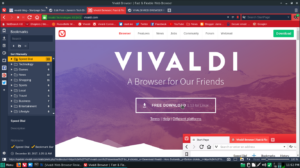Vivaldi Technologies, a company based in Norway, is the company behind the Vivaldi browser. The Vivaldi browser was built with Power users, or technology enthusiasts in mind. It has all the features of Chrome, Firefox, and others with a little something extra. The browser is best suited for people who know what they want, how they want it. Vivaldi started out with a Tech Preview and since its beginning has ran more like a stable release. The browser was meant to replace Opera legacy. It was built in the wake of changes in Opera Software, the changes that Jon Von Tetzchner, didn’t agree with. He was mad after Opera shut down their old community website and he felt that Opera the browser was no more, he felt that the company sold out and so he left Opera and reopened the community site and started to form Vivaldi.
Vivaldi has more built in features than you might really think is necessary, however, where they are heading, these features will come in handy. Vivaldi is an unfinished product, but a very sturdy one. Vivaldi uses Blink, the latest Chromium engine and many of its libraries. Say what you might about Google, but next to Firefox, they have done the most to advance the web. Vivaldi uses a closed source UI which has some people questioning its loyalty to its users, however, Most of what Vivaldi have advanced since releasing the browser has been Merely to the UI and not the inner workings of the browser. Changes made to the UI were adding of tab stacking and audio control in active and inactive tabs, Vivaldi’s own theme support, the ability to switch the placement of the bookmarks bar, the side bar, etc. and more control over browser history. They also added possible hotkeys and mouse gestures.
Vivaldi browser stays up to date with the latest Chrome updates. They do not lag behind like with browsers such as Srware Iron and they do not add hidden proprietary software like with Comodo’s browsers and even Chromium itself. Chromium is the open source project behind Google-Chrome, this means that Vivaldi is largely open sourced, the company just likes to keep a lock on their interface. The browser looks reminiscent of Opera in its earlier days, back when the company was loyal to the community it started with. Vivaldi does listen to its users, it may take time to implement much wanted features, but they do try to make good on their word.
Vivaldi has recently started a personal blogging site on its community page for its users much like blogger for google. They have also released an online email client, but I have yet to verify how well it works. They are also currently working on a sync feature, this will put it at a tipping point agains Chrome, many users who feel stuck on Chrome will now have two browser options to move away from Chrome to. As for privacy, the browser does allow some data collection to Google, but this is just standard for features such as safe browsing and these can be turned on and off in the browser’s UI easily. Vivaldi is quick to render pages, feels even quicker than Chromium, however, that could be placebo. Vivaldi supports nearly all of the Chromium extensions now.
One issue I have with Vivaldi, it takes longer to fire up than even Google-Chrome does. Loading the browser requires a bit more CPU cycles and time than with other browsers, however, if it remains constant and stable, that might not really matter to new users. It looks and feels amazing as a browser. The browser’s slogan is “It’s your web. Surf it the way you want” as printed on their site: https://vivaldi.com.

As you can see, I have their homepage opened now which displays many of their unique features over other browsers right on the front page. It also gives links to the Community page, the news, the forum and the webmail. Here is to Another great year with Vivaldi, let’s hope the next year finds even more improvements.
For more stories: https://techiegeek123.blogspot.com